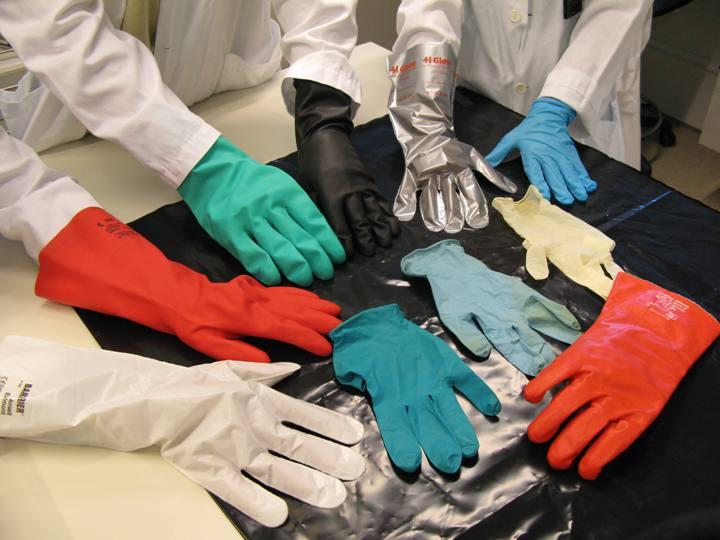Gloves
It is both necessary and desirable to wear gloves within a number of areas of work at the University of Bergen. It is important to wear the correct glove, and when choosing and wearing gloves several factors need to be considered.
Main content
Gloves that protect against chemicals
A large number of different types of gloves are available, differing greatly in their choice of material, design, comfort and effectiveness for the various applications. No protective glove covers all types of effect or task. For optimal protection, in some cases it may be useful to combine several types of glove. Gloves must be worn only when necessary and must be chosen on the basis of:
- The type of exposure present
- What work is to be done
- What the glove needs to provide protection against
- For how long they will be worn
- What level of function is needed when carrying out the work
Choosing the right protective glove to shield against chemicals can be particularly difficult. To make the choice easier, a summary of breakthrough times has been drawn up for the most widely used chemicals and gloves at the University of Bergen: Barrier, Sol-Vex, PVA and Neotop, from the University of Bergen’s framework agreement for PPE:
- At-a-glance chart for checking gloves (new 24th April 2023)
- Information about gloves and contact person at Fisher (new 24th April 2023)
Disposable gloves (medical examination gloves)
Disposable gloves are well suited to shielding sample material from pollution and contamination from the surroundings.
Nitrile is the most suitable material for gloves that are to minimise puncture and cut wounds, though it does not prevent these injuries entirely. People who need to handle syringes and syringe needles that may contain infected material must use special grips or nitrile gloves.
At the University of Bergen, as far as possible natural rubber (latex) gloves should not be used. This is because this type of glove can cause the development of a latex allergy. Vinyl gloves should not be used as they contain reprotoxic phthalates and may release chlorine on combustion.
Other gloves
For other types of protective and working gloves – for example, when working with deep-cooled gases, hot objects, in the forests and fields or park section, etc. – contact the PPE supplier (see the University of Bergen’s framework agreement).
- At-a-glance chart for checking gloves
- Discussion of the Barrier, Sol-Vex, Neotop and PVA
- Annsells glove guide (scroll down the page and select "Permeation and degradation database")
Tips
As well as wearing the correct glove, it is important to practise good hand hygiene and to wear the glove correctly. Good hand hygiene will provide an important barrier to exposure, while correct use will avoid the unnecessary spread of exposure sources. Practical advice when wearing gloves:
- Hands should be clean and dry.
- Rings should not be worn.
- Check that the glove is intact.
- Remove the glove immediately after completing the task, and do not touch everything possible while wearing gloves.
- Replace the glove in good time before the breakthrough time is reached, even if the glove appears to be intact. It should always be remembered that no glove material is impenetrable to chemicals – it is simply a matter of time.
- For greater comfort, wear thin inner gloves made of cotton for use that exceeds 15 minutes.
- Always wash your hands before and after wearing gloves.
- Avoid dry skin; use hand/skin cream when necessary, particularly during the winter period.
Acts and regulations
Useful links
- More information on the use of PPE in the workplace can be found on the Norwegian Labour Inspection Authority website (NO).
